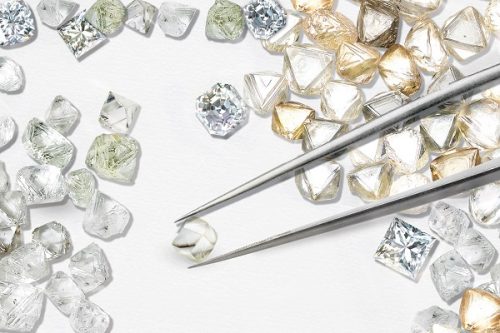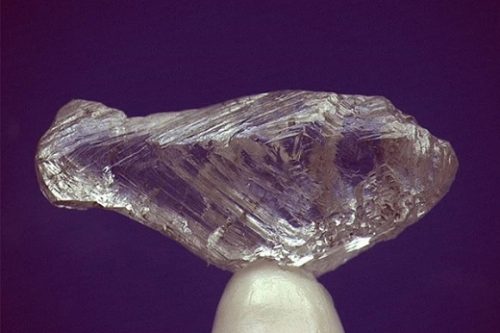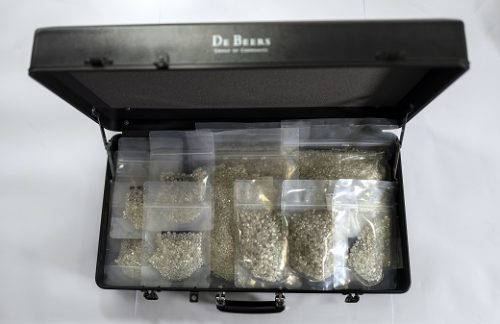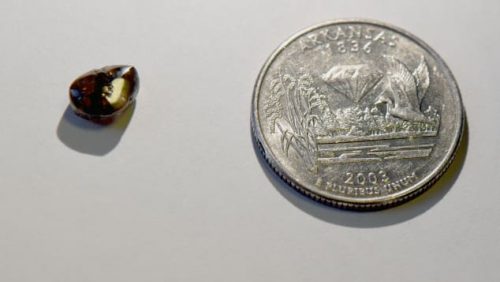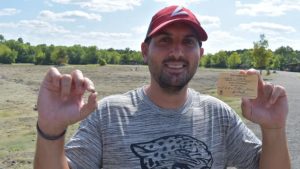Synthetic diamonds are a fundamental threat to the natural diamond industry. They are not just a competitive product like gems, pearls, or gold jewelry. They are a replacement product. Their marketers shout out: Don’t buy natural diamonds, buy synthetic diamonds because synthetic diamonds are more ethical. They are cheaper. They build up synthetic diamonds by tearing down natural diamonds.
The natural diamond trade is confused and afraid. Our diamond distribution system is under relentless attack as retailers are forced to match lower prices from online sellers who operate at lower costs. Furthermore, suppliers are using the internet to sell direct to consumers, cutting out retailers. Competition is fierce, profit margins are low and people are leaving the industry.
The problem is not just distribution. Natural diamonds themselves are under direct attack. Synthetic sellers are mounting marketing and public-relations campaigns to convince consumers that natural diamonds are bad. They claim natural diamonds deface the earth and force child labor. The reputation of our diamonds and trade are being destroyed in the mind of the consumer.
Identity crisis
Our trade is having an identity crisis. Are synthetics more ethical? Are they a good product? Should we sell synthetics? If we sell synthetics, what does that say about us and our natural diamonds?
The synthetic marketing campaigns are just the tip of the iceberg. What’s really going on is an attempt to steal the identity of natural diamonds and hijack the reason people buy diamonds. Synthetics sellers are not saying “Buy synthetics because they are more beautiful, sparkly, or well cut.” They are saying “Buy synthetics because they are the same as natural diamonds but with better ethics and lower prices.” They are getting under our skin by trying to capture the idea and promise of natural diamonds.
Synthetics are parasites living off the marketing message that naturally scarce diamonds are the ultimate gift of love and commitment. Synthetics are trying to steal the Diamond Dream. They don’t have their own message. Synthetics are not more ethical.[1] They don’t contribute to sustainable economic development in developing countries. And most importantly they don’t hold value.
Synthetic prices
Synthetic sellers make a strong argument that synthetic diamonds are “exactly the same”[2] as natural diamonds. But that’s not true. Synthetic diamonds have no natural limitation of supply. They can be cranked out in unlimited quantities and will be manufactured as long as there is profit. Given a competitive market, the quantity and supply of synthetic diamonds manufactured will increase until there is very little price difference between the cost of manufacturing and the sales price. The wholesale B2B price of synthetics is limited to manufacturing costs plus a small distribution profit.
The cost of manufacturing synthetic diamonds is continuously decreasing (it currently stands at $300 to $500 per carat). Technological advances in synthetic processing are being driven by governments and companies seeking to develop a broad range of futuristic synthetic diamond technologies that have nothing to do with jewelry. These include synthetic diamond chips for quantum computers, high-powered CO2 lasers, and even biological applications funded by the US Department of Defense.[3] Extended funding for these advances will create new technology that will further reduce the cost of creating synthetics. Think Moore’s law on steroids.
There are also the tens of thousands of High Pressure-High Temperature (HPHT) machines in China shifting production from creating synthetic diamond abrasives to synthetic gem rough. And let’s not forget about what happened to synthetic emeralds, rubies and sapphires: Their prices plummeted as unlimited production increased supply.
For all the above reasons, it is reasonable and rational to predict that synthetic diamond prices will decline significantly over the next few years. In fact, according to some reports, prices for 1-carat synthetics have fallen over 20% in just the last quarter.
In contrast, the supply of natural diamonds — particularly large expensive diamonds — is limited by their natural occurrence. You can’t just crank them out. Natural diamond prices are based on scarcity and that is why their price per carat increases with size and quality. The scarcer something is the more valuable it is.
Synthetic values
Jewelers considering the sale of synthetic diamond engagement rings should consider the ramifications of what happens when the customer comes back in a few years and finds out that her $30,000 diamond is now worth $3,000 or $300. What will you say? What will you do? Do you think that customer will ever trust you again? Do you think the customer will ever again buy any diamond, synthetic or natural, from you or anyone else again?
Consumers are not being told of the sinking value of their synthetic diamonds. Jewelers are presenting the diamonds as a discounted item compared to natural diamonds even though they are not comparable when it comes to value retention. These jewelers and jewelry companies are misleading consumers who think they are buying a diamond that will retain value the way a natural diamond does. An entire generation of millennials is being “ethically” ripped off.
Sadly, we have an industry that is cashing in on the reputation of natural diamonds. We are destroying the long-term reputation of diamonds as a store of value for short-term synthetic profits. It’s shocking to see so many in our industry willing to take consumers for a ride without disclosing the likely price decline of expensive synthetic diamonds.
The diamond dream
So what is the diamond dream? Why do people buy diamonds? What is the promise of diamonds?
Let’s talk diamond engagement rings. When a man gives a woman a diamond,[4] there is more going on than the physical exchange of a commodity. Similarly, when a couple has a committed relationship, there is more going on than a one-night Tinder experience. We seek to transcend our physical connection by incorporating high-level emotions into a spiritual relationship. We seek to make love, not just have sex. The diamond engagement ring is an emotional and spiritual gift that transcends the physical diamond as it communicates the commitment of love forever. The universally symbolic gift of a diamond engagement ring is similar to a wedding ring, which is “worth” much more than its weight in gold. The value of the wedding ring incorporates the emotional and spiritual investment of the couple. So, too, the diamond engagement ring.
For many young women, the diamond dream is that one day she will fall in love. The perfect man will come along, ask her to marry him and give her a diamond ring to seal that love. The dream starts at a young age — maybe 10 or 12 — and continues throughout her life. Even after she gets married, she will look at the ring every day, remembering the love it represents.
The foundation of diamond demand is the engagement ring. A man does not give an engagement ring to a woman just because it sparkles. He is giving her much more than the physical product. He is giving her his promise to be there for her, for the rest of her life.
The value of values
The natural diamond trade does itself a disservice by promoting diamonds based on price. If the most important thing about the diamond is price then why doesn’t the man just give the woman cash? Many in the trade do not know how to sell the emotional power of the diamond so they just sell price discounting. It is likely that these companies will lose market share to synthetic diamond sellers.
The woman receiving the diamond does not just want price — she wants value. She does not want a commodity transaction; she wants her relationship with her lover to be more than transactional. She wants her man to give her something valuable because she projects the value of the diamond onto herself. She wants to think, “He loves me sooo much, he spent sooo much on me.” Sure, she wants the biggest and best diamond she can get for their money, but most importantly she wants him to show her he loves her by buying her something expensive. Something that has no utility other than to make her feel good and confident about his love for her.
The Achilles heel of synthetic diamonds is that they don’t have the ability to store value. Yet an important part of the diamond dream is the idea that the gift she is receiving is valuable and will stay valuable forever. That is what she is thinking and that is what she is expecting. The fact that no one is telling her the value of her synthetic diamond will deteriorate is a great injustice.
The diamond dream is about the promise of real love, based on real emotions, based on a real diamond that maintains real value. The diamond dream is not about cool technology, celebrating a transactional relationship, or a synthetic diamond that has no long-term value. There is no such thing as a synthetic diamond dream.
Synthetic profits
Our research shows that retailers can make higher profit margins selling synthetic diamonds.
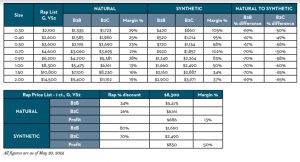
The first table presents wholesale (B2B) and retail (B2C) prices for natural and synthetic diamonds. The second table provides an analysis of how the Rapaport list is being used for natural and synthetic diamonds using the example of fine-cut 1-carat, G-color, VS2-clarity, triple-Ex diamonds.
The gross profit margin based on internet B2B to B2C prices for a 1-carat, G, VS2 synthetic diamond is 50% versus only 13% for a natural diamond. The difference in profit margins is significantly higher for smaller sizes. For example, a 0.30-carat synthetic diamond shows a gross profit margin of 105% versus 29% for natural diamonds. Not only are synthetic diamonds much cheaper to source (-69% B2B price) and easier to sell (-50% B2C price) they are also much more profitable for the retailer. From a price and profit perspective synthetics diamonds are killing natural diamonds.
One reason for this is that retailers are not passing on the lower B2B cost of synthetics to consumers. They price synthetics in comparison to naturals, making consumers think they are getting a good deal. One key question is if such a high markup will be sustainable once B2C competition expands and B2B prices come down. Another question is if brick-and-mortar retailers can gain significantly increased margins for natural diamonds based on their ability to provide added-value services that differentiate the value proposition of natural diamonds.
Given the current pricing and profit structure it’s hard for retailers to ignore the short-term attractiveness of synthetic diamonds. Consider, however, where all of this going. There will be significant declines in the B2B prices as new technology and increased supply impact the market. Competition, particularly internet competition, will be driving down B2C prices and the profitability of synthetics. Synthetic diamonds will be sold in a downward-moving market with continued price competition.
Undoubtedly, short-term temptations will encourage many retailers to sell expensive synthetic diamonds. What will they say to their customers when synthetic diamonds go the way of synthetic emeralds, rubies and sapphires? All of us in the diamond trade face an ethical challenge: short-term profits versus long-term integrity. Leonardo DiCaprio is a great actor and the Titanic was a great ship. But ask yourself, should you be going down with Leonardo’s Titanic?
Synthetic melee and fashion jewelry
So far, our analysis has been limited to expensive engagement rings and the diamond dream. But what about synthetic melee and the market for inexpensive fashion jewelry?
Our primary concern that expensive synthetic diamond prices are unsustainable is not a factor when it comes to inexpensive fashion jewelry. De Beers has set a B2C price of $800 per carat for synthetic polished diamonds in sizes up to 1 carat. Assuming rough production costs are about $300 per carat, there is a limited pricing downside considering the diamonds must be cut, polished, marketed and delivered to consumers. Furthermore, even if melee prices do fall significantly, consumers don’t care if the price of their inexpensive fashion jewelry goes down. We are not talking about an emotional investment in a $5,000-plus engagement ring.
While the high-end jewelry and watch brands will continue to limit their purchases to top-quality natural diamond melee, the market for medium to low-quality natural melee will come under continuous pressure. Competition from synthetic melee will increase as synthetic prices continuously decline due to technological innovation and increased rough production from Chinese HPHT manufacturers. Absent aggressive DPA marketing, consumers probably won’t care if their fashion jewelry contains synthetic or natural diamonds. It’s the look that counts.
Ultimately, if synthetic diamonds become extremely cheap, we may see differentiated demand for natural melee. In the meantime, the fight for the differentiation of low-quality natural melee appears to be lost. There is no marketing support for natural melee. On the contrary, marketers including De Beers are supporting synthetic melee and sizes up to 1 carat in fashion jewelry. Given the lack of differentiation marketing and the extreme difficulties associated with continuous testing for natural melee in inexpensive jewelry, it is likely that natural and synthetic melee markets will merge. Mixed parcels of synthetic and natural diamonds will become the norm. If consumers don’t care, why should retailers or dealers?
High-end jewelry using melee for halo, micro-pavé or other settings will have to implement careful supply chain controls if they wish to ensure natural diamond consistency in their products. In general, we expect increasing supply chain control for high-end jewelry. One area that may benefit from the confusion is the melee market for recycled diamonds, which is expected to do well in light of the increasing emphasis on ethical jewelry sourcing by synthetic suppliers.
Recommendations
It is important to recognize the US Federal Trade Commission’s (FTC) policy that consumers are best served with a wide offering of products and services. Hence, it makes sense for the FTC to legitimize the sale of synthetic diamonds to consumers on the condition that there is full disclosure regarding the nature of the product.
Unfortunately the FTC and our industry trade organizations[5] fail to require proper full disclosure regarding synthetic diamonds.
1. Consumers must be informed that “lab-grown diamond prices are subject to significant risk of lower prices due to the fact that they can be produced in unlimited quantities. Lab-grown diamond prices may diverge significantly from natural diamond prices which are based on natural scarcity related to the size and quality of the diamonds.”
2. Since the FTC has established that synthetic diamonds and natural diamonds are “diamonds,” both types should be treated the same when it comes to treatments. There is no justification for exempting synthetic diamonds from treatment disclosure. Once a synthetic diamond emerges from its HPHT crucible or CVD device, any further treatments must be disclosed. “Treated lab-created diamond” should be an acceptable description. It is fundamentally unfair to require natural diamond disclosure of treatment while exempting synthetic diamonds.
3. The FTC should investigate claims by synthetic diamond companies “guaranteeing the value of your diamond.” Such guarantees only provide credit toward the purchase of other synthetic diamonds. They do not guarantee the value or price paid for the diamonds. Furthermore, statements by Leonardo DiCaprio and others that refer to synthetic diamonds as “real diamonds” should be removed from websites.
4. While the Diamond Producers Association (DPA) is to be congratulated for its landmark study of “The Socioeconomic and Environmental Impact of Large-Scale Diamond Mining,”[6] it must aggressively defend the market for large natural diamonds, particularly engagement rings. It should be highlighting the value-retention difference between natural and synthetic diamonds. Consumers need to know that synthetic diamonds do not retain value due to their unlimited supply.
5. Industry trade organizations must address the issue of melee diamonds that cannot be tested due to their small size, color, tint or low value. Mixed parcels of synthetic and natural diamonds or untested parcels must be recognized as such and traded with full disclosure.
6. The diamond trade must make additional efforts to eliminate “questionable diamonds” from the supply chain. Synthetic diamond producers are breathing down our necks with claims about unacceptable sourcing. Reliance on the Kimberley Process to ensure the legitimacy of diamonds is no longer sufficient or acceptable. New source certification and provenance systems capable of ensuring an ethical supply chain must be encouraged and promptly implemented. Unethical companies and individuals must be excluded from the legitimate diamond trade.
Conclusion
Synthetic diamonds are threatening the integrity of the natural diamond trade by promoting the sale of expensive synthetic diamonds without disclosing their inability to store value. Consumers are being misled about the medium- and long-term value of their synthetic diamonds. Absent full and fair disclosure it is likely that once consumers find out about the “value retention problem” they will no longer be interested in buying any diamonds, including natural diamonds.
As millennials finally come of marriageable age, we are in danger of losing an entire generation of diamond consumers due to our failure to differentiate our natural diamonds from synthetic diamonds based on value retention and other factors. Better marketing focusing on the benefits of natural diamonds compared to synthetic diamonds is desperately needed.
It looks like we have lost the battle for low-quality natural melee diamonds. The benefits of natural diamonds for inexpensive fashion jewelry are unclear. Extensive marketing efforts to brand and sell synthetic diamond jewelry by Swarovski, Diamond Foundry and others are taking place. Nothing similar is being done for natural diamonds.
All of us in the diamond industry face an ethical dilemma: Should we or should we not sell synthetic diamonds? Even with full disclosure about value retention, we will still have the problem of facing consumers who will come back in a few years with worth-less synthetic diamonds.
From the Rapaport perspective we question the ethics of establishing a synthetic diamond trading network on RapNet or publishing a Rapaport price list for synthetics. We do not think it is right to create an enabling environment for products that will hurt consumers.
So as to gain a better understanding of the trade’s position regarding synthetic diamonds, we will be holding a RapNet vote on synthetic diamond issues before the Las Vegas show. Your comments and suggestions are always welcome.
Source: Diamond.net






